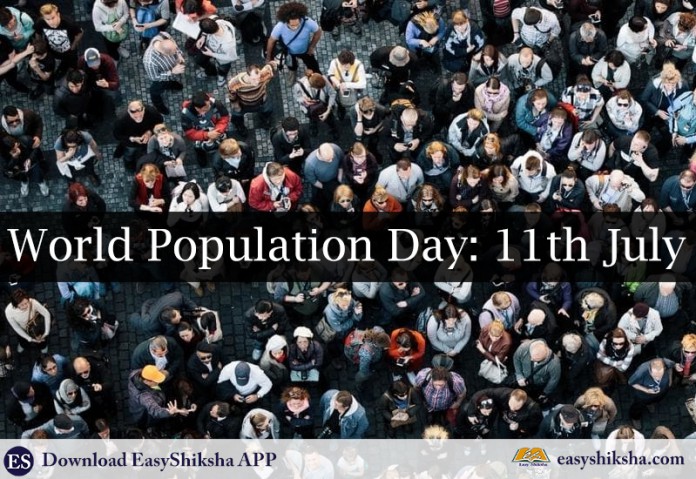There are about 7.2 billion of people on earth and this number is still increasing 1.10 percent. That means we have 83 million new people on earth annually. UN each year have a different theme for each occasion. Back in 2003 the theme was “1 Billion Adolescents”. This year theme is “Family Planning is Human Right”. 2018 is the year of 50th anniversary of 1968 Conference on Human Rights. India was the first country to adopt family planning but still it got issues with population.

Important Announcement – EasyShiksha has now started Online Internship Program “Ab India Sikhega Ghar Se”

Top 10 Facts about World Population Day
-
There were around 400 million people on the planet in 1000 AD and it would take 804 years before the world would add enough people to reach 1 billion by 1804. However, to add another 2 billion to bring the world population up to 3 billion in 1960, it took only about 156 years.
-
Since the 1960s, the global birth rate has fallen to an average of 2.5 births per woman. However, that average is made up of highly diverse figures: in Africa its 4.7 births per woman, in Europe it’s 1.6 births per woman.
-
The world’s population is growing by 1.10 percent per year, or about an additional 83 million people annually. The global population is expected to reach 8.6 billion in 2030, 9.8 billion in 2050 and 11.2 billion in 2100.
-
According to National Health Family Survey 2015-16 (NFHS-4), female sterilization continues to be the most widely used method of contraception in India – accounting for over 75% of the modern family planning methods used.
-
To encourage men to share the burden of family planning, the government has taken a number of initiatives, which includes the promotion of male sterilization, a compensation scheme for sterilization acceptors, etc.
-
It is estimated that about 14 crore couples are currently using modern methods of contraception. This means about four crore unintended pregnancies, 80 lakh births, 13 lakh unsafe abortions and 21,600 maternal deaths would be averted in 2018.
-
India’s maternal mortality rate reduced by 83 percent from 212 deaths per 100,000 live births in 2007 to 178 deaths in 2012. While the global maternal mortality ratio has declined by 44 percent- from 385 deaths to 216 deaths per 100,000 live births.
-
Despite correcting the employment problem, India is expected to become the World’s youngest country with 64 percent of its population in the working age by 2020.
-
An increasing number of people are living to a ripe old age. In 1950, there were far more young than old. In 2017, there are fewer young and more older people. By 2050, the numbers will even out.
Top Courses in Software Engineering Top Courses in Software Engineering
Loading...
-
The initiatives taken by the government of India in implementing the Family Planning Programme have a significant impact on the country as a whole. Over the years, family planning measures have shifted from withdrawal (before ejaculation) to intra-uterine contraceptive devices (IUCDs), and then to contraceptive pills.
——————————————————————————————————————————-
Sign up with EasyShiksha and get free online education account. You can access more than 50 free online courses, various computer and govt exam test series and find your career options. You can Sign up with Facebook
Empower your team. Lead the industry
Get a subscription to a library of online courses and digital learning tools for your organization with EasyShiksha
Request NowQ. Are EasyShiksha's internships truly free?
Yes, all internships offered by EasyShiksha are completely free of charge.
Q. How can I apply for an internship with EasyShiksha?
You can apply by visiting our website, browsing available internships, and following the application instructions provided.
Q. What types of internships are available through EasyShiksha?
EasyShiksha offers a wide range of internships across technology, business, marketing, healthcare, and more. Opportunities are continuously updated.
Q. Will I receive a certificate upon completing an internship?
Yes, upon successful completion, you will receive a certificate recognizing your participation and achievements.
Q. Are EasyShiksha's internship certificates recognized by universities and employers?
Yes, the certificates are recognized by universities, colleges, and employers worldwide.
Q. Is the download of certificates free or paid?
Access to internships and courses is free, but there is a small fee to download certificates, covering administrative costs.
Q. When can I start the course?
You can choose any course and start immediately without delay.
Q. What are the course and session timings?
These are fully online courses. You can learn at any time and pace. We recommend following a routine, but it depends on your schedule.
Q. What will happen when my course is over?
After completion, you will have lifetime access to the course for future reference.
Q. Can I download the notes and study material?
Yes, you can access and download course materials and have lifetime access for future reference.
Q. What software/tools would be needed for the course?
All necessary software/tools will be shared during the training as needed.
Q. I’m unable to make a payment. What should I do?
Try using a different card or account. If the problem persists, email us at info@easyshiksha.com.
Q. Do I get the certificate in hard copy?
No, only a soft copy is provided, which can be downloaded and printed if required.
Q. The payment got deducted but shows “failed”. What to do?
Technical errors may cause this. The deducted amount will be returned to your account in 7-10 working days.
Q. Payment was successful but dashboard shows ‘Buy Now’?
Sometimes payment reflection is delayed. If it takes longer than 30 minutes, email info@easyshiksha.com with the payment screenshot.
Q. What is the refund policy?
If you face technical issues, you can request a refund. No refunds are issued once the certificate has been generated.
Q. Can I enroll in a single course?
Yes, select the course of interest, fill in the details, make payment, and start learning. You will also earn a certificate.
Q. My questions are not listed above. I need further help.
Contact us at info@easyshiksha.com for further assistance.
ALSO READ: Dhe-odisha-3-admission-merit-list-is-declared-today
Get Course: Basic-of-E-Commerce





































































